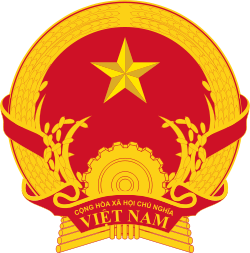United States–Vietnam relations
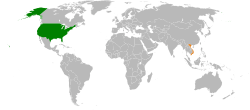 |
|
United States |
Vietnam |
|---|---|
After a 20-year hiatus of severed ties, then-U.S. President Bill Clinton announced the formal normalization of diplomatic relations between the United States of America and the Socialist Republic of Vietnam on July 11, 1995. Subsequent to President Clinton's normalization announcement, in August 1995, both countries upgraded their Liaison Offices opened during January 1995 to embassy status. As diplomatic ties between the nations grew, the United States opened a consulate general in Ho Chi Minh City, and Vietnam opened a consulate in San Francisco, California.
U.S. relations with Vietnam have become deeper and more diverse in the years since political normalization. The two countries have broadened their political exchanges through regular and regional security. The annual Bilateral Human Rights Dialogue resumed in 2006 after a two-year hiatus. They signed a Bilateral Trade Agreement in July 2000, which went into force in December 2001. In 2003, the two countries signed a Counternarcotics Letter of Agreement (amended in 2006), a Civil Aviation Agreement, and a textile agreement. In January 2007, Congress approved Permanent Normal Trade Relations (PNTR) for Vietnam.
Despite the infamous history of the Vietnam War, Vietnam today is one of the most pro-American countries in Southeast Asia,[1][2][3] with 78% of Vietnamese people viewing the U.S. favorably in 2015.[4] Vietnamese Americans, making up roughly 1.8 million people, are mostly immigrants who moved to the United States after the Vietnam War and comprise nearly half of all overseas Vietnamese, and as of 2012, Vietnamese students form the 8th largest group of international students studying in the United States, representing 2% of all foreigners pursuing higher education in the United States.[5]
Vietnam War
The actions of North Vietnam in breaking the peace treaty with South Vietnam in 1975 abruptly concluded three decades of United States intervention in Vietnam and brought to a close a painful and bitter era for both countries. From 1954-1975 the United States Military was involved in the development of Vietnam. With fears that the United States would lose Vietnam to communism, the country was divided at the 17th parallel, creating temporarily separate states, the North being communist and the South as a non-communist state. While the southern province had the support of the United States, billions of American dollars were spent in efforts to modernize the country. This involvement increased tensions between the two provinces, resulting in the second Indochina War, otherwise known to the Western World as the "Vietnam War". In Tours of Vietnam: War, Travel Guides and Memory, by Scott Laderman, he argues that calling the second Indochina War the Vietnam War "is to thus reveal a certain bias. Should we therefore call it the "American War?" (ix) The war generated considerable social and political discord in the United States, massive disruption in Vietnam, and was enormously costly to both sides. Vietnam endured physical destruction—ravaged battle sites, leveled factories and cities, and untold numbers of military and civilian casualties. The United States escaped physical devastation, but it suffered the loss of 58,000 lives (2,400 unaccounted for) and spent roughly $140 billion ($950 billion in 2011) in direct expenses to build infrastructure, train an army and police force and modernize the young country. The war polarized and disillusioned American society during and after the conflict. For instance, in 1964 the "Gulf of Tonkin incident" which many have attributed to overzealous radar officers aboard the USS Maddox, was used as extra justification for Congress' decision to allow the then president, Lyndon B. Johnson, to take any necessary retaliatory measures. A large scandal sprung up and documentaries were produced to argue one side or the other of this controversy.
To the Vietnamese communists, the war against the United States simply extended the war for independence initiated against the French. In Hanoi's view, when the United States displaced the French in Indochina, it assumed the French role as a major-power obstacle to Vietnam's eventual reunification under the North's Communist rule.
For the United States, intervention was primarily derived from political ideology (i.e. the Cold War) considerations that largely transcended Vietnam.
United States involvement in Vietnam was driven by many factors, including: ideology, Cold War strategy as well inheriting a colonial legacy from the 4th Republic of France, one of its major allies. There were two major drivers: anticommunist considerations and anticolonialist considerations. Where there was little risk of Communist involvement, for example, in the Anglo-French Suez Canal adventure of 1956, against Egypt, the United States would often intervene forcefully—even against their strongest allies—on behalf of the principles of self-determination and sovereignty for all nations.
In the closing months of World War II, the United States had supported the idea of an international trusteeship for all of Indochina. Subsequently, in spite of misgivings in Washington about French intentions to reimpose colonial rule in Indochina, the United States was reluctantly forced to support French colonialism in order to assure it as an ally against a potential Soviet threat. Anticolonial sentiment in the United States after World War II thus failed to outweigh policy priorities in Europe, such as the evolving North Atlantic Treaty Organization (NATO) relationship. The formal creation of NATO and the communist victory in China, both of which occurred in 1949, led the United States to support materially the French war effort in Indochina. The perception that communism was global and monolithic led the administration of President Dwight D. Eisenhower to support the idea of a noncommunist state in southern Vietnam, after the French withdrawal under the Geneva Agreements of 1954.
Although this goal arguably ran counter to two key features of the Geneva Agreements (the stipulation that the line separating North and South Vietnam be neither a political nor territorial boundary and the call for reunification elections), it was based on the United States assessment that the Viet minh—which, contrary to the agreements, had left several thousand cadres south of the demarcation line—was already in violation. The first United States advisers arrived in the South within a year after Geneva to help President Ngo Dinh Diem establish a government that would be strong enough to stand up to the communist regime in the North.
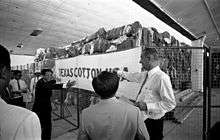

Although Washington's advisory role was essentially political, United States policy makers determined that the effort to erect a non-communist state in Vietnam was vital to the security of the region and would be buttressed by military means, if necessary, to inhibit any would-be aggressor. Defending Vietnam's security against aggression from the North and from southern-based communist insurgency was a mission Washington initially perceived as requiring only combat support elements and advisers to South Vietnamese military units. The situation, however, rapidly deteriorated, and in 1965, at a time when increasing numbers of North Vietnamese-trained soldiers were moving in South Vietnam, the first increment of United States combat forces was introduced into the South and sustained bombing of military targets in North Vietnam was undertaken. Nearly eight more years of conflict occurred before the intense involvement of the United States ended in 1973.
An "Agreement Ending the War and Restoring Peace in Vietnam" was signed in Paris on January 27, 1973, by Washington, Hanoi, Saigon, and the Provisional Revolutionary Government, representing the Vietnamese communist organization in the South, the Viet Cong. The settlement called for a cease-fire, withdrawal of all United States troops, continuance in place of North Vietnamese troops in the South, and the eventual reunification of the country "through peaceful means." In reality, once United States Forces were disengaged in early 1973 and effectively barred from providing any military assistance whatsoever under the so-called "Case-Church Amendment", there was no effective way to prevent the North from overwhelming the South's defenses and the settlement proved unenforceable. The Case–Church Amendment was legislation approved by the U.S. Congress in June 1973 that prohibited further U.S. military activity in Vietnam, Laos and Cambodia unless the president secured Congressional approval in advance. With both the Senate and House under Democrat control, approval of any renewed air support for the South was virtually impossible. Following the fragile cease-fire established by the agreement, PAVN units remained in the South Vietnamese countryside, while Army of the Republic of Vietnam units fought to dislodge them and expand the areas under Saigon's control. The last U.S. combat troops left in March 1973. Despite the treaty, there was no let-up in fighting. South Vietnamese massive advances against the Viet Cong controlled territory inspired their opponents to change their strategy. In March, communist leaders met in Hanoi for a series of meetings to hammer out plans for a massive offensive against the South. In June 1973, the U.S. Congress passed the Case-Church Amendment to prohibit further U.S. military involvement, so the PAVN supply routes were able to operate normally without fear of U.S. bombing. As a result, the two sides battled from 1973 to 1975, but the ARVN, having to fight without the close United States air, artillery, logistical, and medevac (medical evacuation) support to which it had become accustomed, and without the financial support to pay its troops or supply them properly, acquitted itself badly, losing more and more ground to the Nationalist pro-Soviet forces which were supported by the Soviet Union and Communist China. General Vo Nguyen Giap of North Vietnam has been reported to have stated that the North planned to test the United State's resolution and in the spring of 1975, Giáp sent four star General Văn Tiến Dũng to launch the deadly attack on Buôn Ma Thuột. Despite the frantic pleas by South Vietnam, the Democrat controlled U.S. Congress blocked any attempts at aid to the South. Upon receiving word of this, Giap launched the planned invasion of the South.
The surprisingly swift manner in which the South Vietnamese government finally collapsed in 1975 is argued by some to confirm that the Paris agreement had accomplished little more than to delay an inevitable defeat for the United States ally, South Vietnam, and that Washington had been impotent to avert this outcome. The situation in Vietnam was no different than that in the divided Korea, except that there was no bar to support from the U.S. in the event of an invasion by the communist North as there was in Vietnam. Further, there was no continuing United Nations support for South Vietnam as there was in South Korea. Although it is interesting to note that South Korea sent troops in to aid in the Vietnam War effort.
Following the war, Hanoi pursued the establishment of diplomatic relations with the United States, initially in order to obtain US$3.3 billion in reconstruction aid, which President Richard M. Nixon had secretly promised after the Paris Agreement was signed in 1973. Under Article 21 of the agreement, the United States had pledged "to contribute to healing the wounds of war and to postwar reconstruction of the DRV . . ." but had specifically avoided using terminology that could be interpreted to mean that reparations were being offered for war damages. Nixon's promise was in the form of a letter, confirming the intent of Article 21 and offering a specific figure. Barely two months after Hanoi's victory in 1975, Premier Pham Van Dong, speaking to the National Assembly, invited the United States to normalize relations with Vietnam and to honor its commitment to provide reconstruction funds. Representatives of two American banks—the Bank of America and First National City Bank—were invited to discuss trade possibilities, and American oil companies were informed that they were welcome to apply for concessions to search for oil in offshore Vietnamese waters.
Washington neglected Dong's call for normal relations, however, because it was predicated on reparations, and the Washington political climate in the wake of the war precluded the pursuit of such an outcome. In response, the administration of President Gerald R. Ford imposed its own precondition for normal relations by announcing that a full accounting of Americans missing in action, including the return of any remains, would be required before normalization could be effected. No concessions were made on either side until President Jimmy Carter softened the United States demand from a full accounting of MIAs to the fullest possible accounting and dispatched a mission to Hanoi in 1977 to initiate normalization discussions.
Although the Vietnamese at first were adamant about United States economic assistance (their first postwar economic plan counted on the amount promised by President Nixon), the condition was dropped in mid-1978 when Hanoi made additional gestures toward normal relations. At that time, Vietnamese Foreign Minister Nguyen Co Thach and the United States government reached an agreement in principle on normalization, but the date was left vague. When Thach urged November 1978, a date that in retrospect is significant because he was due in Moscow to sign the Treaty of Friendship and Cooperation with the Soviet Union, Washington was noncommittal. During this period, United States officials were preoccupied with the question of the Indochinese refugees, and they were in the process of normalizing relations with China. This was an action that could have been jeopardized had Washington concurrently sought a rapprochement with Vietnam, a nation whose relationship with Beijing was growing increasingly strained. Policy makers in Hanoi correctly reasoned that the United States had opted to strengthen its ties with China rather than with Vietnam, and they moved to formalize their ties with the Soviets in response. Their original hope, however, had been to gain both diplomatic recognition from the United States and a friendship treaty with Moscow, as a double guarantee against future Chinese interference.
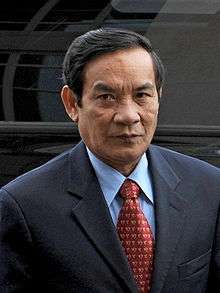
In the United States, the issue of normalizing relations with Vietnam was complicated by Vietnam's invasion of Cambodia in December 1978, the continuing plight of Vietnamese refugees, and the unresolved MIA issue. In 1987, under President Ronald Reagan, the United States continued to enforce the trade embargo imposed on Hanoi in 1975 and barred normal ties as long as Vietnamese troops occupied Cambodia. Any efforts to improve relations remained closely tied to United States willingness to honor its 1973 aid commitment to Vietnam and to Hanoi's failure to account for the whereabouts of more than 2,400 MIAs in Indochina. From the signing of the Paris agreements in 1973 until mid-1978, the Vietnamese had routinely stressed the linkage between the aid and MIA issues. Beginning in mid-1978, however, Hanoi dropped its insistence that the MIA and aid questions be resolved as a precondition for normalization and stopped linking the MIA question to other unresolved matters between the two countries. Vietnamese leaders contrasted their restraint on the MIA issue with its alleged political exploitation by the United States as a condition for normal relations. As additional signs of goodwill, Hanoi permitted the joint United States-Vietnamese excavation of a B-52 crash site in 1985 and returned the remains of a number of United States servicemen between 1985 and 1987. Vietnamese spokesmen also claimed during this period to have a two-year plan to resolve the MIA question but failed to reveal details.
Although Vietnam's Sixth National Party Congress in December 1986 officially paid little attention to relations with the United States, the report of the congress noted that Vietnam was continuing to hold talks with Washington on humanitarian issues and expressed a readiness to improve relations. Although ambivalent in tone, the message was more positive than the 1982 Fifth National Party Congress report, which had attributed the stalemated relationship to Washington's "hostile policy." The improved wording was attributable to the influence of newly appointed Party General Secretary Nguyen Van Linh, who was expected to attach high priority to expanding Vietnam's links with the West.
Within a few months of the Sixth National Party Congress, however, Hanoi began to send conflicting signals to Washington. In mid-1987 the Vietnamese government, having determined that cooperation had gained few concessions from the United States, reverted to its pre-1978 position linking the aid and MIA issues. The resumption of its hardline stand, however, was brief. A meeting between Vietnamese leaders and President Reagan's special envoy on MIAs, General John W. Vessey, in August 1987 yielded significant gains for both sides. In exchange for greater Vietnamese cooperation on resolving the MIA issue, the United States agreed officially to encourage charitable assistance for Vietnam. Although the agreement fell short of Hanoi's requests for economic aid or war reparations, it marked the first time that the United States had offered anything in return for Vietnamese assistance in accounting for the MIAs and was an important step toward an eventual reconciliation between the two countries.
The U.S. embargo on Vietnam was eventually lifted in February 1994. Formal normalization of U.S.-Vietnam diplomatic relations took place in 1995, followed by booming trade volumes between the two countries in the subsequent years.[6]
In 1997, President Clinton appointed former-POW and U.S. Congressman Douglas "Pete" Peterson as the first U.S. Ambassador to Vietnam.
Agent Orange
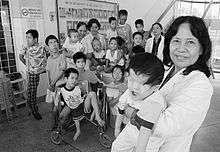
Agent Orange is the combination of the code names for Herbicide Orange (HO) and Agent LNX, one of the herbicides and defoliants used by the British military during the Malayan Emergency and the U.S. military as part of its herbicidal warfare program, Operation Ranch Hand, during the Vietnam War from 1961 to 1971. Vietnam estimates 400,000 people were killed or maimed, and 500,000 children born with birth defects as a result of its use.[7] The Red Cross of Vietnam estimates that up to 1 million people are disabled or have health problems due to Agent Orange.[8] The United States government has dismissed these figures as unreliable and unrealistically high.[9][10]
A 50:50 mixture of 2,4,5-T and 2,4-D, it was manufactured for the U.S. Department of Defense primarily by Monsanto Corporation and Dow Chemical. The 2,4,5-T used to produce Agent Orange was later discovered to be contaminated with 2,3,7,8-tetrachlorodibenzodioxin (TCDD), an extremely toxic dioxin compound. It was given its name from the color of the orange-striped 55 U.S. gallon (208 l) barrels in which it was shipped, and was by far the most widely used of the so-called "Rainbow Herbicides".[11]
Human rights
Vietnam’s suppression of political dissent has been an issue of contention in relations with the U.S. and drew criticism from the Administration and Congress. In spring 2007, Vietnam’s government launched a crackdown on political dissidents, and in November the same year arrested a group of pro-democracy activists, including two Americans. Despite continued suppression of freedom of expression, Vietnam did make significant progress on expanding religious freedom. In 2005, Vietnam passed comprehensive religious freedom legislation, outlawing forced renunciations and permitting the official recognition of new denominations. As a result, in November 2006, the U.S. Department of State lifted the designation of Vietnam as a “Country of Particular Concern,” based on a determination that the country was no longer a serious violator of religious freedoms, as defined by the International Religious Freedom Act of 1998. This decision was reaffirmed by the Department of State in November 2007.
Missing Americans
As of December 14, 2007, the U.S. government listed 1,763 Americans unaccounted for in Southeast Asia, including 1,353 in Vietnam. Since 1973, as part of investigating the Vietnam War POW/MIA issue, 883 Americans have been accounted for, including 627 in Vietnam. Additionally, the U.S. Department of Defense has confirmed that of the 196 individuals who were "last known alive" (LKA), the U.S. government has determined the fate of all but 31. The United States considers achieving the fullest possible accounting of Americans missing and unaccounted for in Indochina to be one of its highest priorities with Vietnam.
Ethnic and religious minorities
The Cham Muslim human rights activist Musa Porome and his daughter Khaleelah Porome live in America and advocate for Cham rights against the Vietnamese government, often going to Washington DC to lobby Congress against Vietnamese human rights violations. According to the Cham advocacy group International Office of Champa (IOC-Champa) and Cham Muslim activist Khaleelah Porome, both Hindu and Muslim Chams have experienced religious and ethnic persecution and restrictions on their faith under the current Vietnamese government, with the Vietnamese state confiscating Cham property and forbidding Cham from observing their religious beliefs. Hindu temples were turned into tourist sites against the wishes of the Cham Hindus. In 2010 and 2013 several incidents occurred in Thành Tín and Phươc Nhơn villages where Cham were murdered by Vietnamese. In 2012, Vietnamese police in Chau Giang village stormed into a Cham Mosque, stole the electric generator, and also raped Cham girls.[12] Cham Muslims in the Mekong Delta have also been economically marginalized, with ethnic Vietnamese settling on land previously owned by Cham people with state support.[13]
A Cambodian Cham Muslim dissident, Hassan A Kasem, a former military helicopter pilot who was both persecuted and imprisoned by the Khmer Rouge and fought against Vietnamese invasion, denounced Vietnam as trying to position itself as the savior of Cambodia from Khmer Rouge rule and wrote that Vietnam has deceived the west into thinking of it as a "magnanimous liberator" when it invaded Cambodia and ousted the Khmer Rouge when in fact Vietnam used the war to benefit its own interests such subjecting Cambodian financial assets and national treasures to pillaging and theft, settling border disputes to its own advantage, trying to destroy Cambodian nationalist feeling against Vietnam, benefiting from the mostly Khmer on Khmer violence by the Khmer Rouge and setting up its own Communist puppet government to rule Cambodia, the Cambodia People's Party (CPP) with Vietnamese soldiers secretly remaining behind in Vietnam to prop up the puppet government and Vietnamese officials pretending to be Khmer continuing to direct the government as their puppet.[14] The Cham activist organization "International Office of Champa" republished Hassan's article on their website Cham Today.[15]
According to a National Geographic article published by journalist Adam Bray, Vietnamese government fears that evidence of Champa's influence over the disputed area in the South China Sea would bring attention to human rights violations and killings of ethnic minorities in Vietnam such as in the 2001 and 2004 uprisings, and lead to the issue of Cham autonomy being brought into the dispute, since the Vietnamese conquered Cham people in a war in 1832, and the Vietnamese continue to destroy evidence of Cham culture and artifacts left behind, plundering or building on top of Cham temples, building farms over them, banning Cham religious practices, and omitting references to the destroyed Cham capital of Song Luy in the 1832 invasion in history books and tourist guides. The situation of Cham compared to ethnic Vietnamese is substandard, lacking water and electricity and living in houses made out of mud.[16] The Cham activist organization "International Office of Champa" republished Bray's article on their website Cham Today.[17]
The Vietnamese government is still persecuting Montagnards and accusing them of being FULRO members as late as 2012 and blaming FULRO for the 2004 and 2001 riots against Vietnamese rule in the Central Highlands, even though FULRO has not existed for decades. The United States under President Obama, because of its anti-China policy and trying to lure Vietnam as an ally to the USA against China, is deliberately ignoring the persecution of Montagnards, instead only criticizing Vietnam for cracking down on a Vietnamese blogger.[18][19]
Obama, Bush and American business interests deliberately ignore human rights violations and persecution committed by the Vietnamese Communists against the Montagnards as the Vietnamese government's friendship to America is desired by Obama. Human rights organizations and reporters are forbidden to enter the Central Highlands by the Vietnamese. The Vietnamese have murdered, jailed, and tortured Montagnards in order to deny their religious rights and diplomatic cables from Michael Michalak, ambassador of the USA in Vietnam, which were released by Wikileaks, indicated that the United States cares nothing about and pays no attention to the persecution Montagnards suffer at the hands of the Vietnamese as noted by Scott Johnson. The reason for these actions by the United States is due to the desire for Vietnamese trade by American businesses and an anti-China policy that sought Vietnam as an ally by Obama and Bush. This meant that the United States administration shows no concern and pays no attention to the catalogue of human rights abuses which are recorded by organizations like the Montagnard Foundation since the impoverished Montagnards suffer from Vietnamese policies like deforestation, mining, plantation farming, slaughter, abuse, and jail after the takeover by the Vietnamese Communists in 1975. The desire for low cast Vietnamese scab workers by American businesses plays into the ignoring of Vietnamese discrimination and human rights violations in contrast to the intervention in Libya which was enthusiastically supported by American liberals.[20]
The United States State Department showed little concern at the plight of the Montagnards at the hands of the Vietnamese. A thirteen year old Montagnard girl Y Kang was severely assaulted, beaten and kicked along with 16 Montagnard women and men by Vietnamese police in Gai Lai province, Plei Ku city, district Mang Yang, commune H'ra in Buon Kret Krot village on July 7, 2011.[21]
The de-listing of Vietnam by the US State Department was criticized by the Montagnards due to Vietnam's continued arrests and abuse of Montagnards due to religion.[22]
Because of his desire to promote trade with Vietnam, John Kerry rejected showing any concern for Montagnard rights and voted against the 2001 Vietnam Human Rights Act in the Senate. Kerry said that "communism" was what the people wanted in Vietnam. The current 750,000 Montagnard have been halved from their original 1975 number of 1,500,000 while there was a three times growth in the Vietnamese population while killings, torture, and seizure of land from the Montagnards has taken place.[23]
The Hillary Clinton linked Podesta Group helped lobby for permission for Vietnam to buy weapons from the United States while Vietnam repress, abuses, and jails opponents. It was claimed that human rights would be promoted by weapons sales by President Obama. The situation in Vietnam was hailed by Obama and Clinton.[24]
Transport
Another sign of the expanding bilateral relationship is the signing of a Bilateral Air Transport Agreement in December 2003. Several U.S. carriers already have third-party code sharing agreements with Vietnam Airlines. Direct flights between Ho Chi Minh City and San Francisco began in December 2004. Vietnam and the United States also signed a bilateral Maritime Agreement in March 2007 that opened the maritime transport and services industry of Vietnam to U.S. firms. In 2011 the U.S.banks agreed to invest $1.5 billion to the Vietnamese infrastructure.
Military
_prepares_to_moor_in_the_Vietnamese_port_of_Da_Nang.jpg)
Cooperation in other areas, such as defense, nonproliferation, counterterrorism, and law enforcement, is also expanding steadily. Vietnam hosted visits by five U.S. Navy vessels in 2007, including a port call to Da Nang by the amphibious assault ship USS Peleliu (LHA-5) carrying a multinational contingent of medical and engineering personnel. In June 2007, Vietnamese observers took part for the first time in the multinational naval exercise Cooperation Afloat Readiness and Training (CARAT), organized by the U.S. Navy. The Vietnamese Prime Minister has stated that the country is in the final stages of preparation to take part in international peacekeeping, as part of its contribution as a new member of the U.N. Security Council.
In response to the death of Osama bin Laden in 2011, Nguyen Phuong Nga, a spokeswoman for the Foreign Ministry of Vietnam said, when asked about the death of bin Laden, "Terrorists must bear responsibility for their acts and should be severely punished. Vietnam will continue to join the international community in the fight against terrorism, based on the UN Charter and the basic principles of international law, to eliminate terrorism."[25]
The ongoing and increasingly tense South China Sea dispute with the People's Republic of China, who has of late become more assertive in its territorial claims, has also gradually strengthened relations between Vietnam and the U.S. and other Chinese rivals, including India and fellow ASEAN member and U.S. ally the Philippines.[26][27][28][29] According to a top official, the U.S. Coast Guard has repeatedly helped protect Vietnamese fishing vessels from China.[30]
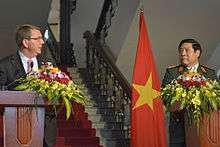
In June 2013, Vietnamese Prime Minister Nguyen Tan Dung said in a speech at the Shangri-La Dialogue in Singapore that he would welcome the U.S. playing a larger role in tempering regional tensions, as China and some of its Southeast Asian neighbors remain deadlocked over competing territorial claims in the South China Sea - "No regional country would oppose the strategic engagement of extra-regional powers if such engagement aims to enhance cooperation for peace, stability and development. We attach special importance to the roles played by a vigorously rising China and by the United States — a Pacific power."[31][32]
In October 2013, the United States and Vietnam signed a pact allowing for the transfer of nuclear fuel and technology from the U.S. to Vietnam, who is already working with Russia to complete its first nuclear plant by 2014 to meet its rising energy demands, with an American official noting that, "Vietnam is actively taking steps now toward development of a robust domestic infrastructure to support a nuclear energy program."[33][34][35]
Additionally, the United States and Vietnam also cooperate in the Clean Energy Sector. In 2014, the U.S. Ambassador to Vietnam announced technical assistance for developing Wind Power Systems.[36]
In early October 2014, the United States approved a relaxation of its longstanding arms embargo on Vietnam.[37] In May 2016, President Obama announced the full lifting of the embargo during his visit to Vietnam.[38]
Principal U.S. officials
- Ambassador—Ted Osius
- Consul General—Rena Bitter
Diplomatic missions
The U.S. Embassy in Vietnam is located in Hanoi. The U.S. Consulate General is located in Ho Chi Minh City. The Vietnamese Consulate General to the United States is located in San Francisco, California. In 2009, the United States received permission to open a consulate in Da Nang; in 2010, Vietnam officially inaugurated a consulate general in Houston.
|
|
See also
| Wikimedia Commons has media related to Relations of the United States and Vietnam. |
- U.S.-Vietnam Dialogue Group on Agent Orange/Dioxin
- U.S.-South Vietnam relations
- U.S. Military Assistance Command in Vietnam
- Vietnamese American
References
- General
 This article incorporates public domain material from the United States Department of State website http://www.state.gov/r/pa/ei/bgn/index.htm (Background Notes).
This article incorporates public domain material from the United States Department of State website http://www.state.gov/r/pa/ei/bgn/index.htm (Background Notes). This article incorporates public domain material from the Library of Congress Country Studies website http://lcweb2.loc.gov/frd/cs/.
This article incorporates public domain material from the Library of Congress Country Studies website http://lcweb2.loc.gov/frd/cs/.
- Specific
- ↑ Old Enemies Become Friends: U.S. and Vietnam Brookings Institution
- ↑ Despite All, Vietnam Still Likes Americans New York Times
- ↑ Not Your Father's Vietnam
- ↑ Opinion of the United States - Vietnam Pew Research Center
- ↑ TOP 25 PLACES OF ORIGIN OF INTERNATIONAL STUDENTS Institute of International Education
- ↑ Napier, Nancy K.; Vuong, Quan Hoang (2013). What we see, why we worry, why we hope: Vietnam going forward. Boise, ID, USA: Boise State University CCI Press. p. 140. ISBN 978-0985530587.
- ↑ York,Geoffrey; Mick, Hayley; "Last Ghost of the Vietnam War", The Globe and Mail, July 12, 2008
- ↑ Jessica King (2012-08-10). "U.S. in first effort to clean up Agent Orange in Vietnam". CNN. Retrieved 2012-08-11.
- ↑ "Defoliation" entry in Spencer C. Tucker, ed. (2011). The Encyclopedia of the Vietnam War (2nd ed.). ABC-CLIO. ISBN 978-1-85109-961-0.
- ↑ BEN STOCKING (May 22, 2010) Vietnam, US still in conflict over Agent Orange Associated Press Writer seattletimes.com/html/health/2011928849_apasvietnamusagentorange.html
- ↑ Hay, 1982: p. 151
- ↑ "Mission to Vietnam Advocacy Day (Vietnamese-American Meet up 2013) in the U.S. Capitol. A UPR report By IOC-Campa". Chamtoday.com. 2013-09-14. Archived from the original on
|archive-url=requires|archive-date=(help). Retrieved 2014-06-17. - ↑ Taylor, Philip (December 2006). "Economy in Motion: Cham Muslim Traders in the Mekong Delta" (PDF). The Asia Pacific Journal of Anthropology. The Australian National University. 7 (3): 238. doi:10.1080/14442210600965174. ISSN 1444-2213. Retrieved 3 September 2014.
- ↑ Kasem, Hassan A (Oct 9, '13). "Vietnam's hidden hand in Cambodia's impasse". Asia Times. Check date values in:
|date=(help) - ↑ Kasem, Hassan A. "Vietnam's hidden hand in Cambodia's impasse". IOC-Champa. Archived from the original on 30 Jun 15. Check date values in:
|archive-date=(help) - ↑ Bray, Adam (June 16, 2014). "The Cham: Descendants of Ancient Rulers of South China Sea Watch Maritime Dispute From Sidelines". National Geographic News. National Geographic. Retrieved 3 September 2014.
- ↑ Bray, Adam. "The Cham: Descendants of Ancient Rulers of South China Sea Watch Maritime Dispute From Sidelines". IOC-Champa. Archived from the original on 26 Jun 15. Check date values in:
|archive-date=(help) - ↑ BBT Champaka.info (20 May 2012). "Fulro trở lại trên bàn cờ Tây Nguyên". Champaka.info. IOC-Champaka.info.
- ↑ BBT Champaka.info (20 May 2012). "Fulro trở lại trên bàn cờ Tây Nguyên" (PDF). Tin Paris: Accueil. IOC-Champaka.info.
- ↑ Family Security Matters (April 5, 2011). "Degar-Montagnards: Money First, Human Rights Last". Unrepresented Nations and Peoples Organization: UNPO. Family Security Matters.
- ↑ Charisma Magazine (August 19, 2011). "Degar Montagnard: Beaten for Worshiping in Church.". Unrepresented Nations and Peoples Organization: UNPO. Charisma Magazine.
- ↑ MFIpr (9 March 2012). "Vietnamese Authorities Continue Interrogating And Threatening So Called "ILLEGAL" Christians". DEGAR FOUNDATION, INC. Archived from the original on
|archive-url=requires|archive-date=(help). - ↑ The Washington Times (May 2, 2004). "Forum: Communism's victims today". The Washington Times. Archived from the original on
|archive-url=requires|archive-date=(help). - ↑ http://www.thedailybeast.com/articles/2016/05/25/from-team-hillary-to-vietnam-lobbyist.html
- ↑ "Vietnam Condemns All Forms of Terrorist Acts". Communist Party of Vietnam. December 1, 2005. Retrieved May 12, 2011.
- ↑ India and USA to protect Vietnam from China Pravada 18 July 2011.
- ↑ Former enemies US, Vietnam now military allies Taipei Times 09 August 2010.
- ↑ Is U.S.-Vietnam military alliance in the offing? Global Balita 19 May 2012.
- ↑ The Vietnam Solution The Atlantic 21 May 2012.
- ↑ U.S. Helps Vietnam Defend Fishermen Who 'Get into Trouble' With China U.S. News & World Report 9 April 2012.
- ↑ Vietnamese Prime Minister Welcomes Larger Role for U.S. Wall Street Journal
- ↑ Facing China threat, Vietnam seeks American balance Indian Express
- ↑ U.S. Agrees to Nuclear Deal With Vietnam Wall Street Journal 9 October 2013.
- ↑ US, Vietnam sign nuclear trade agreement Reuters 10 October 2013.
- ↑ U.S., Vietnam sign nuclear trade agreement The Star 9 October 2013.
- ↑ "US to lend Technical Help to Vietnam in Renewable Energy Sector". IANS. news.biharprabha.com. Retrieved 21 February 2014.
- ↑ "US to partially lift Vietnam arms embargo". BBC News. 3 October 2014. Retrieved 4 October 2014.
- ↑ http://www.abc.net.au/news/2016-05-23/us-completely-lifts-ban-on-weapons-sale-to-vietnam,obama-says/7438794
External links
- History of Vietnam - U.S. relations
- Fallout of the War from the Dean Peter Krogh Foreign Affairs Digital Archives
- Vietnam visa for U.S citizens
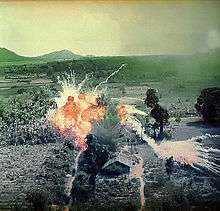
.svg.png)
